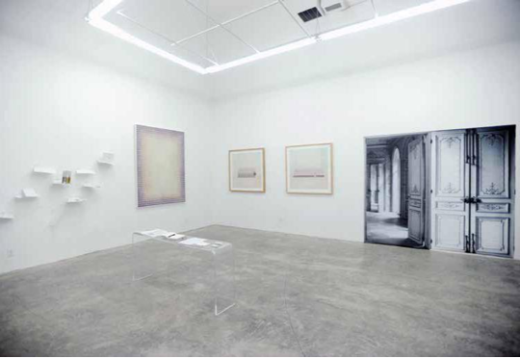Ceci n’est pas une peinture (This is not a painting)
Santino Sini

Installation view: Ceci n’est pas une peinture (This is not a painting), Art Lexïng
May 9–June 20, 2016
Art Lexïng in Miami Ironside is framed by tall, thin cypress trees. A bocce court of gray stones and a perimeter of pink, curvilinear seating can be found just outside in the courtyard. Ceci n’est pas une peinture (This is not a painting) is a small, deceptive collection of works. Viewers are presented with objects from the Tokyo design studio YOY, the Paris fashion house Maison Margiela, and artists Quentin Shih, Ye Hongxing, and Zheng Jiang. According to curator Lexing Zhang, this collection largely points toward trompe l’oeil. In doing so, each piece offers a duplicity in function or facade.
The objects by YOY and Maison Margiela are purposeful, in the utilitarian sense, in that they function as simple household items, though mockingly so. Stretched across a tilted canvas, YOY’s printed image of a Victorian parlor settee seems to be only a visual play, but in fact effectively bends to the sitter’s rump, warping from two-dimensional to three-dimensional object when put to use. Equally deceptive are Maison Margiela’s smaller pieces, displayed on shelves perched atop the wall like flown-away papers. A doorstop shaped as an egg, a notebook spirally bound at both ends like an asylum inmate, a “travel candlestick” that is framed by mirrors, multiplying in the grasp of the handler.
The accompanying artists carry out their own deceptions. Zheng Jiang’s Dusk (date?) wears the colors of a falling sun, a large tempera painting of short, pretty strokes, arranged within a likeness to the flowering apple of Chinese patterned glass. Quentin Shih’s manipulated photography imposes a contrast of European fashion models within a bleak palette and surreal setting. The subjects’ relation to the background and viewer is both distant and rigid, yet, in the artist’s manipulation, there also exists a playful and soft air.
Perhaps most eye-catching are the brightly colored collages by Ye Hongxing, composed of the kind of stickers sold in sheets at bodegas and dollar stores. The arrangements are sugary and tightly packed at close range; from afar, they form traditional, floral guises. In the presence of so much double-sidedness, and faced with the shifty characters of very regal faux doors (Maison Margiela’s Hausmannian door), it is nice to sit and rest—unexpectedly engulfed in a two-dimensional chair like the onset of a time warp.










